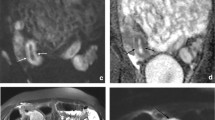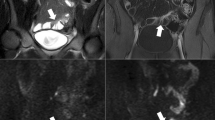Abstract
Our objective was to assess the diagnostic value of magnetic resonance enteroclysis (MRE) compared with conventional enteroclysis (CE) in patients with Crohn’s disease. A secondary objective was to evaluate the diagnostic accuracy of each different MR sequence. Sixty-six consecutive patients with known Crohn’s disease underwent MRE and CE. Fast imaging employing steady-state acquisition (FIESTA), single-shot fast spin-echo (ssFSE), and contrast-enhanced T1-weighted sequences were assessed by two radiologists who reached a consensus about the following findings: visualization of wall ulcers, pseudopolyps, fistulae, mural stenosis, and mesenteric abnormalities. Standard descriptive statistics and the McNemar test were used. The sensitivity, specificity and accuracy of MRE were 90–87% and 83% for the depiction of parietal ulcers, 84%–88% and 86% for pseudopolyps, 100–94% and 96% for mural stenosis, 93–100% and 94% for fistulae. The number of detected extraluminal findings was significantly higher with MRE (P<0.01). The accuracy of FIESTA sequence was statistically higher in the depiction of wall ulcers and fistulae than that of three-dimensional fast spoiled gradient echo (3D-FSPGR) (P<0.01) and ssFSE (P<0.05) sequences. Contrast-enhanced 3D-FSPGR was superior for mural stenosis visualization compared to ssFSE (P<0.05) and FIESTA (P<0.05). MRE correlates accurately with CE in the detection of superficial and transmural abnormalities and has the advantage of assessing the mesenteric manifestations.







Similar content being viewed by others
References
Herlinger H, Caroline DF (2000) Crohn’s disease of the small bowel. In: Gore RM, Levine MS (eds) Textbook of gastrointestinal radiology, 2nd edn. Saunders, Philadelphia, Pa, pp 726–745
Rossini FP, Pennazio M (2000) Small bowel endoscopy. Endoscopy 32:138–145
Chong AKA, Taylor A, Miller A, Hennessy O, Connel W, Desmond P (2005) Capsule endoscopy vs push enteroscopy and enteroclysis in suspected small-bowel Crohn’s disease. Gastrointest Endosc 61:255–261
Dixon PM, Roulston ME, Nolan DJ (1993) The small bowel enema: a ten year review. Clin Radiol 47:46–48
Maglinte DD, Chernish SM, Kelvin FM, Oʹ Connor KW, Hage JP (1992) Crohn disease of the small intestine: accuracy and relevance of enteroclysis. Radiology 184:541–545
Makò EK, Mester AR, Tarjan Z, Karlinger K, Toth G (2000) Enteroclysis and spiral CT examination in diagnosis and evaluation of small bowel Crohn’s disease. Eur J Radiol 35:168–175
Gore RM, Balthazar EJ, Ghahremani GG, Miller FH (1996) CT features of ulcerative colitis and Crohn’s disease. AJR Am J Roentgenol 167:3–15
Schwerk WB, Beck K, Raith M, et al (1992) A prospective evaluation of high resolution sonography in the differential diagnosis of inflammatory bowel disease. Eur J Gastroenterol Hepatol 4:173–182
Wills JS, Lobis IF, Denstman FJ (1997) Crohn disease: state of the art. Radiology 202:597–610
Bender GN, Timmons JH, Williard WC, Carter J (1996) Computed tomographic enteroclysis: one methodology. Invest Radiol 31:43–49
Shoenunt JP, Semelka RC, Magro CM, et al (1994) Comparison of magnetic resonance imaging and endoscopy in distinguishing the type and severity of inflammatory bowel disease. J Clin Gastroenterol 19:31–35
Lee JK, Marcos HB, Semelka RC (1998) MR Imaging of the small bowel using the HASTE sequence. AJR Am J Roentgenol 170:1457–1463
Ernst O, Asselah T, Cablan X, Sergent G (1998) Breath-hold fast spin-echo MR imaging of Crohn’s disease. AJR Am J Roentgenol 170:1457–1463
Low RN, Sebrechts CP, Politoske DA, et al (2002) Crohn disease with endoscopic correlation: single-shot fast spin-echo and gadolinium enhanced fat-suppressed spoiled gradient-echo MR imaging. Radiology 222:652–660
Gourtsoyiannis N, Papanikolaou N, Grammatikakis J, Prassopoulos P (2002) MR enteroclysis: technical considerations and clinical applications. Eur Radiol 12:2651–2658
Umschaden HW, Gasser J (2003) MR enteroclysis. Radiol Clin North Am 41:231–248
Umschaden HW, Szolar D, Gasser J, Umschaden M, Haselbach H (2000) Small bowel disease: comparison of MR enteroclysis images with conventional enteroclysis and surgical findings. Radiology 215:717–725
Masselli G, Brizi MG, Parrella A, et al (2004) Crohn disease: magnetic resonance enteroclysis. Abdom Imaging 29:326–334
Maglinte DD, Siegelman ES, Kelvin FM (2000) MR enteroclysis: the future of small bowel imaging? Radiology 215:639–641
Rubesin SE, Maglinte DD (2003) Double-contrast barium enema technique. Radiol Clin North Am 41:365–376
Shrake PD, Rex DK, Lappas JC, Maglinte DD (1991) Radiographic evaluation of suspected small-bowel obstruction. Am J Gastroenterol 86:175–178
Przemioslo RT, Ciclitira PJ (1995) Pathogenesis of Crohn’s disease. QJM 88:525–527
Chernish SM, Maglinte DD, O’ Connor K (1992) Evaluation of the small intestine by enteroclysis for Crohn’s disease. Am J Gastroenterol 87:696–701
Carucci LR, Levine MS (2002) Radiographic imaging of inflammatory bowel disease. Gastroenterol Clin North Am 31:93–117
Hara AK, Leighton JA, Sharma VK, Heigh RI, Fleischer DE (2005) Imaging of small bowel disease: comparison of capsule endoscopy, standard endoscopy, barium examination, and CT. Radiographics 25:697–711
Boudiaf M, Jaff A, Soyer P, Bouhnik Y, Hamzi L, Rymer R (2004) Small-bowel diseases: prospective evaluation of multi-detector row helical CT enteroclysis in 107 consecutive patients. Radiology 233:338–344
Marcos HB, Semelka RC (2000) Evaluation of Crohn’s disease using half-Fourier RARE and gadolinium-enhanced SGE sequences: initial results. Magn Reson Imaging 11:127–135
Horsthuis K, Lavini C, Stoker J (2005) MRI in Crohn’s Disease. J Magn Reson Imaging 22:1–12
Ha HK, Lee EH, Lim CH, et al (1998) Application of MRI for small intestinal diseases. J Magn Reson Imaging 8:357–383
Ajaj W, Goehde SC, Schneemann H, Ruehm SG, Debatin JF, Lauenstein TC (2004) Oral contrast agents for small bowel MRI: comparison of different additives to optimize bowel distension. Eur Radiol 14:458–464
Borthne AS, Abdelnoor M, Hellund JC, Geitung JT, Storaas T, Gjesdal KI, Klow NE (2005) MR imaging of the small bowel with increasing concentrations of an oral osmotic agent. Eur Radiol 15:666–671
Sood RR, Joubert I, Franklin H, Doyle T, Lomas DJ (2002) Small bowel MRI: comparison of a polyethylene glycol preparation and water as oral contrast media. J Magn Reson Imaging 15:401–408
Masselli G, Brizi MG, Menchini L, Minordi L, Vecchioli Scaldazza A (2005) Magnetic resonance enteroclysis imaging of Crohn’s. Radiol Med 110:221–233
Prassopoulos P, Papanikolau N, Grammatikakis J, et al (2001) MR enteroclysis imaging of Crohn’s disease. Radiographics 21:161–172
Gourtsoyiannis N, Papanikolau N, Grammatikakis J, Maris T, Prassopoulos P (2001) MR enteroclysis protocol optimization: comparison between 3d FLASH with fat saturation after intravenous gadolinium injection and true FISP sequences. Eur Radiol 11:908–913
Maglinte DD, Gourtsoyiannis N, Rex D, Howard TJ, Kelvin FM (2003) Classification of small bowel Crohn’s subtypes based on multimodality imaging. Radiol Clin N Am 41:285–303
Furukawa A, Saotome T, Yamasaki M, et al (2004) Cross-sectional Imaging in Crohn disease. Radiographics 24:689–702
Narin B, Ajaj W, Gohde S, Langhorst J, Akgoz H, Gerken G, Ruhm SG, Lauenstein TC (2004)Combined small and large bowel MR imaging in patients with Crohn’s disease: a feasibility study. Eur Radiol 14:1535–1542
Herlinger H, Furth EE, Rubensin SE (1998) Fibrofatty proliferation of the mesentery in Crohn disease. Abdom Imaging 23:446–448
Meyers MA, McGuire PV (1995) Spiral CT demonstration of hypervascularity in Crohn disease: “vascular jejunization of the ileum or the “comb sign”. Abdom Imaging 20:327–332
Gourtsoyiannis N, Papanikolaou N, Grammatikakis J, Papamastorakis G, Prassopoulos P, Roussomoustakaki M (2004) Assessment of Crohn’s disease activity in the small bowel with MR and conventional enteroclysis: preliminary results. Eur Radiol 14:1017–1024
Author information
Authors and Affiliations
Corresponding author
Rights and permissions
About this article
Cite this article
Masselli, G., Casciani, E., Polettini, E. et al. Assessment of Crohn’s disease in the small bowel: prospective comparison of magnetic resonance enteroclysis with conventional enteroclysis. Eur Radiol 16, 2817–2827 (2006). https://doi.org/10.1007/s00330-006-0338-7
Received:
Revised:
Accepted:
Published:
Issue Date:
DOI: https://doi.org/10.1007/s00330-006-0338-7




